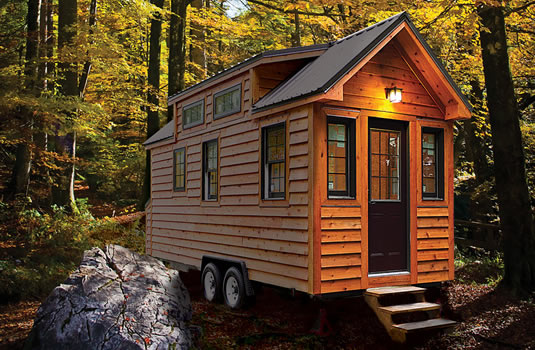Lighten up your lifestyle and reduce your carbon footprint by moving into a smaller home. It seems like that's exactly what a lot of people are doing, which is why tiny homes are becoming so popular. Read more about trend below:
When Macy Miller’s 2,500-square-foot Idaho home was foreclosed in 2007 after her divorce, she became enamored with the idea of scaling down her lifestyle. “I have absolutely zero interest in tying myself up with that kind of loan ever again,” she told Bloomberg. Miller is just one of many “real-estate refugees.”
By 2011, Miller had taken matters into her own hands (literally) and built herself a 196-square-foot-timber home on a trailer in Boise, Idaho. It took her 18 months to complete, for a grand total of $11,000, debt-free. She pays $200 a month to rent the land it sits on and shares the space with her partner, their baby and a 100-pound Great Dane named Denver.
Miller’s story is not uncommon as people across the nation look for creative and innovative ways to avoid being locked into large mortgages and debt — which in turn free’s up time and money, while increasing the overall quality of life. Tiny house advocates also point out that smaller spaces require less maintenance and significantly reduce time spent cleaning. Plus they use far less materials for construction compared to an average house, thereby reducing their environmental impact. Moreover, many are designed to be off-grid — with solar panels, rainwater collection systems and composting toilets.
But city zoning laws and restrictions have proven to be a formidable obstacle for many tiny homes — although this is slowly changing. Many have worked around cumbersome city codes by placing their tiny houses on trailers, which transforms them into a mobile home, as far as city officials are concerned. Others have planted their houses far in the country where governmental oversight is less of an issue. States like New Mexico and Texas are both a hotbed of tiny houses, largely because of lax building codes. And some inventive entrepreneurs are working with city planners to create posh tiny home communities that fall under the forgiving classification of a mobile home park. All in all, where there’s a will, there’s a way — and people are making it work, even in densely populated locations like Washington D.C., as seen with Boneyard Studios.
Opting for a smaller home may seem like a real challenge for some, but often the benefits outweigh the cutbacks. The fact that they cost less is a huge perk as is no longer having to worry about a lot of expensive house bills! If you're creative you can make use of your space, even if it may mean cutting back some.
Have you considered downsizing your home or lifestyle?
Source: Wake-up World
Featured Image via Tiny Home Builders

But this won’t do. Agenda 21 specifies we’ll be crowded into little apartments in big cities. If uoh plan on down sizing on your own remote property beef up your guns n’ ammo arsenal & prepare to defend.
Lowve ft to
Love to win
plus 19 more little buildings to house the preps..
I WISH.
Jon time to start building
guess so